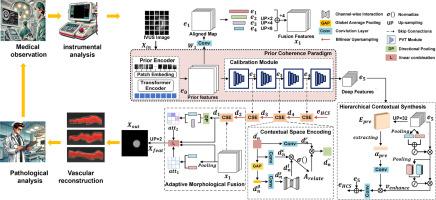在标签稀缺的情况下,用于血管内超声图像自我监督辅助血管分割的先验协调多尺度合成网络
IF 7.6
1区 计算机科学
Q1 COMPUTER SCIENCE, ARTIFICIAL INTELLIGENCE
引用次数: 0
摘要
血管内超声(IVUS)成像在辅助冠状动脉疾病的诊断和干预方面是非常宝贵的。然而,由于分割IVUS图像和准确量化斑块负担和病变严重程度所需的时间增加,其使用受到限制。为了克服这一限制,我们提出了一种用于标签稀缺条件下IVUS图像分割的先验协调多尺度合成网络(PricoMS)。该网络集成了一个先验连贯范式(PCP),通过保持跨尺度的一致性来增强结构综合,以及一个分层上下文综合(HCS)模块,促进上下文信息的整合,以更好地理解空间。为了解决IVUS数据中标签稀缺性的挑战,先验编码器反复利用未标记的IVUS图像进行训练,为分割任务提供图像的先验特征。此外,该网络采用自适应形态融合-上下文空间编码(AMF-CSE)模块来捕获多尺度和上下文数据,从而增强模型识别复杂血管特征的能力,即使在具有次优质量和成像伪像(如电子噪声、斑点噪声、运动伪像和声散射)的具有挑战性的区域。PricoMS表现出强大的性能,在检测管腔边界和检测外弹性膜(EEM)边界方面的Dice得分分别达到95.2%和84.0%,超过了许多现有技术。源代码可在以下网址公开访问:https://github.com/IMOP-lab/PricoMS-Pytorch。本文章由计算机程序翻译,如有差异,请以英文原文为准。

PricoMS: Prior-coordinated multiscale synthesis network for self-supervised–aided vessel segmentation in intravascular ultrasound image amidst label scarcity
Intravascular ultrasound (IVUS) imaging is invaluable in aiding diagnosis and intervention of coronary artery disease. However its use is limited because of the increased time needed to segment the IVUS images and accurately quantify plaque burden, and lesion severity. To overcome this limitation we present a prior-coordinated multiscale synthesis network (PricoMS) for segmenting IVUS images under the condition of label scarcity. This network integrates a prior coherence paradigm (PCP), which enhances structural synthesis by maintaining consistency across scales, and a hierarchical contextual synthesis (HCS) module, which facilitates the integration of contextual information for better spatial understanding. To address the challenge of label scarcity in IVUS data, a prior encoder repeatedly utilizes unlabeled IVUS images for training, providing prior features of the images for segmentation tasks. Additionally, this network employs an adaptive morphological fusion-contextual space encoding (AMF-CSE) module to capture multi-scale and contextual data, thereby bolstering the model†™s capability to discern intricate vascular features even in challenging areas with suboptimal quality and imaging artifacts such as electronic noise, speckle noise, motion artifacts, and acoustic scattering. PricoMS exhibits robust performance, achieving a Dice score of 95.2% for detecting the lumen border and 84.0% for detecting the external elastic membrane (EEM) border, surpassing many existing techniques. The source code is publicly accessible at: https://github.com/IMOP-lab/PricoMS-Pytorch.
求助全文
通过发布文献求助,成功后即可免费获取论文全文。
去求助
来源期刊

Knowledge-Based Systems
工程技术-计算机:人工智能
CiteScore
14.80
自引率
12.50%
发文量
1245
审稿时长
7.8 months
期刊介绍:
Knowledge-Based Systems, an international and interdisciplinary journal in artificial intelligence, publishes original, innovative, and creative research results in the field. It focuses on knowledge-based and other artificial intelligence techniques-based systems. The journal aims to support human prediction and decision-making through data science and computation techniques, provide a balanced coverage of theory and practical study, and encourage the development and implementation of knowledge-based intelligence models, methods, systems, and software tools. Applications in business, government, education, engineering, and healthcare are emphasized.
 求助内容:
求助内容: 应助结果提醒方式:
应助结果提醒方式:


